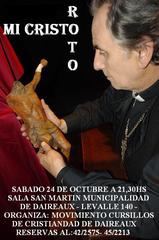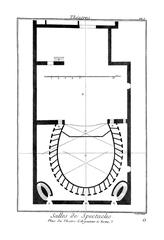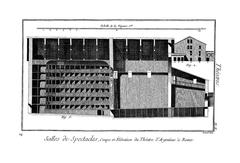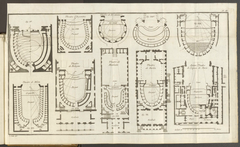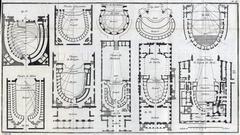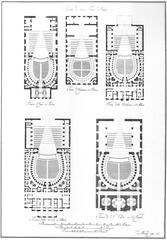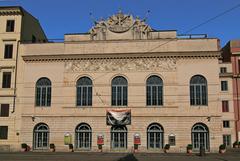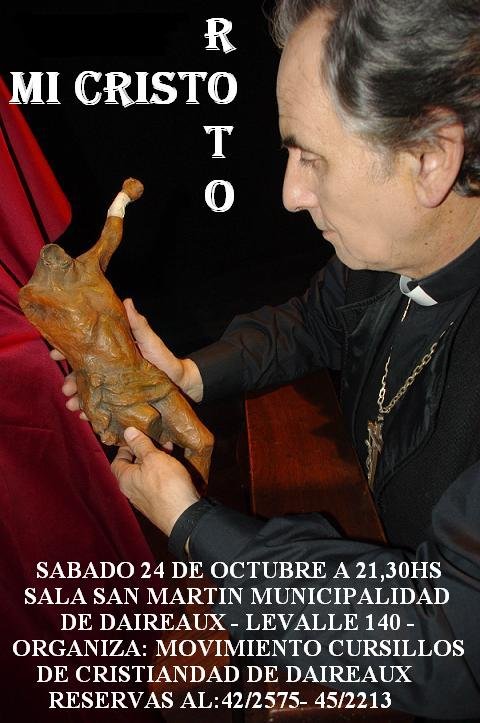
Teatro Argentina Rome: Visiting Hours, Tickets, and Historical Significance
Date: 14/06/2025
Introduction
Nestled in the historic heart of Rome, Teatro Argentina stands as one of the city’s oldest and most iconic cultural venues. Built atop the ancient Curia of Pompey—the very site where Julius Caesar was assassinated—this theater is both a testament to Rome’s layered past and a vibrant center for the performing arts today. With its elegant horseshoe-shaped auditorium, rich operatic heritage, and ongoing commitment to theatrical innovation, Teatro Argentina offers visitors an immersive experience of Rome’s artistic and historical legacy (turismoroma.it; wikipedia).
This guide details everything you need to plan your visit, including Teatro Argentina visiting hours, ticketing options, accessibility information, and highlights of its unique cultural significance. Whether you are a history enthusiast, opera lover, or traveler seeking authentic Roman culture, Teatro Argentina is a must-visit destination (teatrodiroma.net; rome.info).
Table of Contents
- Introduction
- Historical Overview
- Architectural and Artistic Features
- Visitor Information
- Visitor Experience and Tips
- Frequently Asked Questions (FAQ)
- Plan Your Visit
- Conclusion
- References
Historical Overview
Ancient Foundations
Teatro Argentina’s location in Largo di Torre Argentina places it atop the ruins of the Curia of Pompey, the very chamber where Julius Caesar was assassinated in 44 BCE. This historic setting fuses ancient political intrigue with the vibrancy of modern performance (barcelo.com; wikipedia). The name “Argentina” derives from Johannes Burckardt of Strasbourg (Latin: Argentoratum), who constructed the Torre Argentina tower, lending its name to both the square and the theater (teatrodiroma.net).
18th and 19th Century Developments
Commissioned by the Sforza Cesarini family and designed by the Marquis Gerolamo Theodoli, Teatro Argentina opened in 1732 with Domenico Sarro’s Berenice. Its classic horseshoe-shaped auditorium, six tiers of boxes, and ornate red velvet interiors quickly established it as a focal point of Roman social and artistic life (wikipedia; teatrodiroma.net).
The 19th century saw Teatro Argentina become a central stage for operatic premieres, including Rossini’s Il Barbiere di Siviglia (1816) and Verdi’s La Battaglia di Legnano (1849), both of which resonated with the city’s political and cultural evolution. The theater was also synonymous with the Roman Carnival and became a platform for political expression during Italy’s unification (rome.info; turismoroma.it).
Restoration and Preservation
Teatro Argentina has undergone multiple careful restorations, most notably in 1993 under architect Paolo Portoghesi. These efforts preserved its original 18th-century color schemes, decorative elements, and the grandeur of its gilded and velvet-adorned interiors (teatrodiroma.net). The theater now seats nearly 700 and remains a premier venue for both tradition and innovation (flavorofitaly.com).
Architectural and Artistic Features
Teatro Argentina’s architecture exemplifies classic Italian theater design, with a U-shaped auditorium engineered for optimal acoustics and sightlines. The five tiers of balconies feature ornate gilded moldings and red velvet, reflecting the opulence of Rome’s artistic golden age. The neoclassical façade, added in the 19th century, aligns the theater with contemporary Roman trends.
Inside, visitors find frescoes, stucco, and historical commemorations—including plaques marking the 1816 premiere of Il Barbiere di Siviglia. The theater’s integration with its ancient Roman site adds an extra layer of intrigue, making every performance a journey through time.
A celebrated artwork, a 1747 painting by Giovanni Paolo Panini, immortalizes a grand event at Teatro Argentina and underscores its importance in European cultural history (Panini’s Painting).
Visitor Information
Visiting Hours
- General Opening: Tuesday to Sunday, 10:00 AM to 6:00 PM
- Performance Days: Hours may vary; always check the official website before your visit.
Tickets and Pricing
- Performance Tickets: €15–€70 depending on production and seating.
- Museum Admission: Often included with performance tickets; small fee for separate visits.
- Discounts: Available for students, seniors, and groups.
- Purchase: Online via the official site, at the box office, or through authorized vendors.
Guided Tours and Special Events
- Tours: Available by appointment, offering insight into the theater’s history and backstage areas.
- Events: Includes opera, drama, dance, and seasonal festivals. Check the current schedule.
Accessibility
- Partial Accessibility: Ramps and elevators are available, though some upper tiers may be difficult to access.
- Assistance: Contact the theater in advance to arrange for specific needs or accommodations.
Location and Nearby Attractions
- Address: Largo di Torre Argentina, 52, Rome, Italy
- Getting There: Accessible via multiple bus and tram lines; walking distance to the Pantheon, Campo de’ Fiori, and Piazza Navona.
- Nearby Sights: Largo di Torre Argentina archaeological site, Pantheon, Piazza Venezia, and vibrant local restaurants and cafes.
Visitor Experience and Practical Tips
- Dress Code: Smart casual is recommended, especially for evening performances.
- Etiquette: Arrive early; latecomers may be seated only during breaks. Photography is restricted during performances.
- Language: Most performances are in Italian; some international events may feature surtitles or English programs.
Frequently Asked Questions (FAQ)
Q: What are Teatro Argentina’s visiting hours?
A: Tuesday to Sunday, 10:00 AM–6:00 PM; check for performance day variations.
Q: How do I purchase tickets?
A: Online via the official website, at the box office, or through authorized outlets.
Q: Is Teatro Argentina wheelchair accessible?
A: The theater is partially accessible; contact in advance for assistance.
Q: Are guided tours available?
A: Yes, by appointment. See the official website for details.
Q: What are the best nearby attractions?
A: The Largo di Torre Argentina ruins, Pantheon, and Piazza Navona are all within walking distance.
Plan Your Visit
For up-to-date performance schedules, ticketing, and accessibility information, always consult the official Teatro Argentina website. Consider downloading the Audiala app for live audio guides and event updates. Arrive early to explore the historic district, enjoy local dining, and capture photos of the iconic façade.
Conclusion
Teatro Argentina is more than a venue—it is a living monument where Rome’s ancient and modern cultures converge. From its ties to the Roman Republic and the assassination of Julius Caesar to its role as a beacon of Italian theater and opera, Teatro Argentina offers an unparalleled journey through history and art. Plan your visit to immerse yourself in the enchanting world of Rome’s performing arts and experience the magic of a true cultural landmark.
References
- Teatro Argentina Rome: Visiting Hours, Tickets & Historical Guide, turismoroma.it
- Teatro Argentina, Wikipedia
- Teatro Argentina Official Site, teatrodiroma.net
- Teatro Argentina Visiting Hours, Tickets, and Historical Insights, flavorofitaly.com
- Teatro Argentina Visitor Guide, secretroma.com
- Teatro Argentina: A Visitor’s Guide to Rome’s Historic Cultural Landmark, rome.info
- Panini’s Painting
- barcelo.com
For official information, visual media, and virtual tours, visit the Teatro Argentina website.
